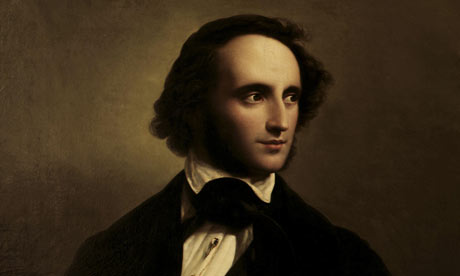Contrasted yet mutable, Mendelssohn and Brahms works spotlighted by Chamber Music Society

Music of Felix Mendelssohn was performed by the Chamber Music Society of Lincoln Center Friday night at Alice Tully Hall.
Since last December the Chamber Music Society of Lincoln Center has worked its way through an abridged, roughly chronological history of classical music, starting with Bach and ending with the 21st century. For its final two concerts of the season in Alice Tully Hall, the society pedaled back to revisit two composers in the middle of the Romantic era: Mendelssohn and Brahms.
The program notes confusingly explain the pairing as a way of bookending the period of Romantic. This is a bit of a stretch. Mendelssohn (1809-1847) certainly sits on the earlier side of this era, but he was predated by Beethoven and Schubert. Meanwhile plenty of richly lyrical romantics followed Brahms, like Antonin Dvorak and Erno Dohnanyi, just to name two who were featured in a previous CMS concert this season.
However, the juxtaposition of these two Hamburg natives, born 24 years apart, does provide a compelling if narrowly focused musical evolution throughout their lifetimes. Divided in two symmetrical parts, each program half featured short pieces for piano and a late string quintet, pointing contrasts between Mendelssohn’s more conservative and classicist style and the emotive and world-weary world of Brahms.
Gilbert Kalish opened the concert with four of Mendelssohn’s Songs Without Words. These are modest works that Mendelssohn published in a series geared toward well-bred women who entertained company by playing popular tunes of the time. Kalish brought a quiet restraint to the rippling melodies in the first two selections, “Venetianisches Gondellied” (Op. 19b, No. 6 and Op. 30, No. 6). The latter pair offered a bit more flourish, as Op. 67, No. 2 featured a syncopated dancing rhythm and Op. 67, No. 4, “Spinnerlied,” was a finger-twirling scherzo that Kalish deftly executed.
The lucid Mendelssohn works made post-intermission offerings by Brahms seem all the more edgy and expressive. Kalish provided a searching account of the Intermezzo in A minor, Op. 76, No. 7, luxuriating in harmonic dissonances. The Capriccio in G minor, Op 116, No. 3, was symphonic in scale with its blustery beginning and end, sandwiching a touching middle-section reverie. Finally, Kalish performed the introspective Intermezzo in B Minor, Op 119, No. 1, a work written after the death of Brahms’s sister, with a reflective quietude.
The generalizations broke down in the pair of string quintets. Violinists Shmuel Ashkenasi and Philip Setzer, violists Arnaud Sussmann and Richard O’Neill, and cellist Paul Watkins were featured in Mendelssohn’s String Quintet No. 2 in B-flat, Op. 87, written two years before he died.
The opening Allegro was well balanced but somewhat restrained, while the Andante with its mocking pizzicatos was delicately handled. For the Adagio, the quintet presented Mendelssohn at his most romantic, emphasizing the ominous tremolos rustling prominently below swooning violin lines. The ensemble attacked the final movement, with Ashkenasi nimbly playing the virtuosic main theme.
In the latter half, Ashkenasi and Setzer, as well as Sussmann and O’Neill, switched chairs for Brahms’s Quintet in G Major, Op. 111. The first movement, a dense thicket of sound in which the cello carries the melody through pulsating violins and violas, was aptly lush, and Watkin’s honeyed tones effortlessly asserted themselves above the harmony. For the waltz-like third movement, the quintet played rather haltingly—this was not music for dancing—which provided a more solemn tone to the quintet, often considered one of Brahms’s most joyful works. (One of the composer’s friends compared it to the Prater, an amusement park in Vienna). O’Neill was particularly expressive in the first viola solos. From these moody depths, the quintet jumped into a vibrant Vivace, ending with a raucous flourish.
The program will be repeated 5 p.m. Sunday. chambermusicsociety.org; 212-875-5788.
